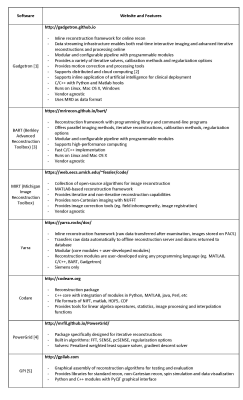Open-Source Reconstruction Systems
1National Heart Lung and Blood Institute, National Institutes of Health, Bethesda, MD, United States
Synopsis
This talk will summarize the features of open source MR image reconstruction software projects and provide illustrative examples of software usage.
Introduction
Modern MR imaging relies on undersampled acquisitions paired with advanced reconstruction techniques with high computational complexity, including parallel imaging methods, compressed sensing, model-based reconstruction, machine-learning based reconstruction and non-Cartesian image reconstructions. Fast implementations of these algorithms leverage computation resources including GPUs and cloud computing, and vendor-provided reconstruction platforms are often insufficient. In the context of contemporary MR imaging, researchers are commonly relying on custom reconstruction software for algorithm development as well as for clinical deployment of new reconstruction methods.
A number of open source reconstruction tools and software platforms have been developed to address the need for fast and robust custom reconstruction methodology. Moreover, these tools enable reproducible research and algorithm sharing between research sites.
Open Source Reconstruction Software
The following online resources provide comprehensive lists and detailed descriptions of open-source reconstruction projects:
- Open Source Imaging (https://www.opensourceimaging.org)
- MR-Hub (https://www.ismrm.org/MR-Hub/)
- MRI Unbound (https://www.ismrm.org/mri_unbound/)
Table 1 summarizes the features of open-source reconstruction software packages including:
- Gadgetron [1,2]: http://gadgetron.github.io
- BART (Berkley Advanced Reconstruction Toolbox) [3]: https://mrirecon.github.io/bart/
- MIRT (Michigan Image Reconstruction Toolbox): https://web.eecs.umich.edu/~fessler/code/
- Yarra: https://yarra.rocks/doc/
- Codare: http://codeare.org
- PowerGrid [4]: http://mrfil.github.io/PowerGrid/
- GPI [5]: http://gpilab.com
All of these software platforms provide a powerful set of reconstruction tools. Gadgetron and Yarra are “inline” reconstruction platforms, referring to export of raw data to a server for reconstruction such that images appear in the DICOM database. In the case of Gadgetron, data is streamed for interactive real-time and fast reconstruction while the patient is in undergoing examination. The others are “offline” reconstruction platforms where data is manually reconstructed on an external computer with appropriate computational power.
Table 2 outlines other useful tools for custom reconstruction, such as:
- Vendor-agnostic raw data formats: MRD [6] (http://ismrmrd.github.io) and .ra (https://github.com/davidssmith/ra)
- Raw data repositories for algorithm development: mridata.org
- Non-uniform FFT tools: NUFFT [7] (http://web.eecs.umich.edu/~fessler/irt/irt/nufft/)and gpuNUFFT (https://github.com/andyschwarzl/gpuNUFFT).
Some institutions/labs provide application-specific tools freely online, for example:
- Center for Advanced Imaging Innovation and Research, NYU: https://cai2r.net/resources/software
- University Hospital of Tubingen and Institute of Signal Processing and System Theory, University of Stuttgart: https://sites.google.com/site/kspaceastronauts/
- Computational Biomedical Imaging Laboratory, University at Buffalo: https://www.acsu.buffalo.edu/~leiying/cbil/index_files/software.htm
This is not an exhaustive list, but rather some representative examples. As more journals and funding bodies encourage algorithm sharing, we anticipate this list will grow in the coming years.
Conclusion
There is a dynamic and growing community of researchers that are developing and sharing new software for MRI reconstruction. These open source tools are advancing MRI technology development.Acknowledgements
No acknowledgement found.References
- Hansen, M.S. and T.S. Sørensen, Gadgetron: an open source framework for medical image reconstruction.Magn Reson Med, 2013. 69(6): p. 1768-76.
- Xue, H., et al., Distributed MRI reconstruction using gadgetron-based cloud computing.Magn Reson Med, 2014.
- Uecker, M., et al., Berkeley Advanced Reconstruction Toolbox, in Proceedings of the 23rd annual meeting of the International Society for Magnetic Resonance in Medicine. 2015: Toronto. p. 2486.
- Cerjanic, A., et al. PowerGrid: A open source library for accelerated iterative magnetic resonance image reconstruction. in Proc Intl Soc Magn Reson Med. 2016.
- Zwart, N.R. and J.G. Pipe, Graphical programming interface: A development environment for MRI methods.Magn Reson Med, 2015.74(5): p. 1449-60.
- Inati, S.J., et al., ISMRM Raw data format: A proposed standard for MRI raw datasets.Magn Reson Med, 2016.
- Fessler, J.A., On NUFFT-based gridding for non-Cartesian MRI.J Magn Reson, 2007. 188(2): p. 191-5.

